Pipe Technician Killed by Coke Oven Gas Pipe Explosion
Michigan Case Report: 08MI001
Summary
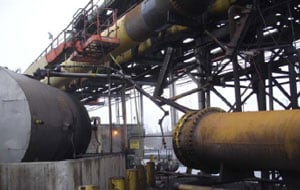
|
|
Figure 1. Incident Scene. 54-inch pipeline blown apart, area where patch repair occurred, and man lift used to elevate workers to pipeline repair area.
|
On January 5, 2008, a 27-year-old male pipe technician was killed when he was struck by pieces of pipeline and explosion forces from a 54-inch coke oven gas (COG) pipe that exploded during repair activities. The site owner had subcontracted the company for whom the decedent worked to perform pipeline repairs. A by pass pipeline had been constructed on a 42-inch live COG pipe to an unused 54-inch COG pipe to allow for repairs in the future on the 42-inch COG pipe. The live 42-inch COG pipe was pressurized to 200 inches water column. The decedent and two crewmembers were hand tapping and using a pneumatic drill to affix gasketed steel cladding to patch the 54-inch pipe while two additional crewmembers were working on the ground. One patch was successfully installed before lunch. After lunch, the crew returned to work and was working on a second patch using a pneumatic drill and hand taps. Shortly after lunch, the three workers were affixing the second of three patches when an explosion occurred in the 54-inch pipe. The pipeline blew apart (Figure 1). The decedent’s two coworkers survived and both made their way to the ground. The decedent was killed as a result of the explosion. After the dust from the explosion settled, the decedent was observed in his fall protection harness hanging upside down from the pipe’s supporting ironwork near the area of the explosion. Emergency response was called. The site owner’s security team arrived and began resuscitative efforts. Emergency personnel arrived and the decedent was declared dead.
Recommendations
- Employers should always treat pipes as “active” and test pipes for explosive gases before initiating and/or continuing work on the pipe after a period of inactivity.
- Employers who are performing work on machines or equipment where unexpected energization, start-up or release of stored energy could occur and cause injury should always place their own lock(s) on the machinery/equipment if their workers are scheduled to be the first to perform work.
- Site owners and subcontractors should ensure that effective communication is established for all site work.
Introduction
On January 5, 2008, a 27-year-old male pipe technician was killed when he was struck by pieces of pipeline and explosion forces from a 54-inch coke oven gas (COG) pipe that exploded during repair activities. On January 7, 2008, MIFACE investigators were informed of this work-related fatality by the Michigan Occupational Safety and Health Administration (MIOSHA) personnel, who had received a report on their 24-hour-a-day hotline. On February 5, 2008, MIFACE interviewed the company owner at the company work trailer at the site owner’s facility. During the course of writing this report, the police report and pictures, death certificate, medical examiner report, and the MIOSHA file and citations were reviewed. All pictures used in this report are courtesy of the MIOSHA file.
The company for whom the decedent worked repaired pipes, vessels and steam pipes, and conducted on-site hot tapping, field machining and other specialty industrial services. The decedent’s job title was pipe technician/line repair technician. He was an hourly employee and worked full time. The decedent’s employer had been hired for the past 12 years by the site owner to conduct repairs/maintenance activities for all pipelines on the site. The decedent’s employer had been in business for longer than 30 years. At the time of the incident, the firm had 12 employees, five who had the same job title as the decedent. His normal work hours were 7:30 a.m. to 4:30 p.m., but he would work overtime as needed. The decedent had been performing work at the facility site for six months. The decedent was wearing the required personal protective equipment to perform the job task: hearing protection, eye protection, hand protection, respiratory protection, hard hat, fall protection, and air monitoring equipment for carbon monoxide.
The company had a written health and safety program, developed by a private consultant. The health and safety program contained sections on Welding, Cutting and Brazing and Lockout/Tagout. The Welding, Cutting and Brazing section included information about welding or cutting containers, and specified that no welding, cutting or other hot work should be performed on used containers/drums, but did not include a section on pipelines. The Lockout/Tagout section included a jobsite evaluation. The site owner was responsible to evaluate the jobsite and determine which machines or pieces of equipment required steps to shut down, isolate, block and secure to control hazardous energy.
The company owner was designated as the safety coordinator. Safety responsibilities were delegated to the general foreman. The firm did not have a health and safety committee. In addition to job task meetings, toolbox talks were held frequently using a checklist to prompt discussion. The facility site owner also provided training to subcontractors on the site. The decedent’s employer utilized equipment manufacturing representatives to provide specialized training to its employees.
The site owner required attendance at hazardous job meetings by all pertinent subcontractors and facility personnel. The meeting identified hazardous job procedures and hazard abatement responsibilities. A Hazardous Job meeting check list was completed, highlighting hazardous job elements, safety equipment required, required permits (e.g. hot work, monitoring, confined space, etc.), in addition to other identified issues (e.g. ignition sources, special communications).
If the decedent’s employer hired subcontractors, the decedent’s employer held appropriate safety meetings with all of their subcontractors in accordance with the site owner requirements.
With the exception of the day of the incident, all appropriate work permits had been pulled and air monitoring performed. Combustible gas levels were 0% through the duration of all testing on the unused 54-inch pipe.
Company Mitigation
After the incident, the decedent’s employer made several changes to their safety program:
- The safety program was reviewed and updated.
- All pipes are now treated as “active”. The air within the pipe must be tested prior to any work performed.
- A hazardous job assessment is performed on all pipeline work.
- A new checklist to cover hazardous work was developed. The checklist is more comprehensive. The previous checklist relied on personal knowledge.
- Comprehensive refresher training was held.
- A health and safety committee was developed. Committee meets quarterly.
- A safety incentive program was developed.
MIOSHA Construction Safety and Health Division issued the alleged Serious citations citing The Control Of Hazardous Energy Sources, Part 85 at the conclusion of the investigation:
- RULE 1910.0147(d)(5)(i): Insure that following the application of lockout or tagout devices to energy isolating devices, all potentially hazardous stored or residual energy shall be relieved, disconnected, restrained, and otherwise rendered safe.
Employees failed to ensure that piping was adequately bled and/or purged before attempting to drill and tap into 54-inch coke oven pipe line, outside blast furnace area with pneumatic drill.
- RULE 1910.0147(c)(4)(i) ADOPTED BY RULE 8502: Develop, document and utilize procedures for the control of potentially hazardous energy when employees are engaged in service or maintenance of machines or equipment where unexpected energization, start-up or release of stored energy could occur and cause injury.
No lockout devices affixed to energy isolating valves on sections of coke oven gas piping line prior to attempting to drill into 54-inch coke oven gas pipeline.
- RULE 1910.0147(c)(7)(i)(a) ADOPTED BY RULE 8502: Provide training to each authorized employee on the recognition of applicable hazardous energy sources, the type and magnitude of the energy available in the workplace, and the methods and means necessary for energy isolation and control.
Inadequate training, employees only apply locks to valves to isolate energy when working on systems that are live.
Investigation
The site owner had a damaged 42-inch pipeline that was carrying coke oven gas (COG). Because the 42-inch pipe required repairs, the owner wanted to use a nearby abandoned 54-inch pipeline, which had not been used for 10 years, to act as a bypass pipe for the COG from the damaged area of the 42-inch line. The project encompassed establishing bypass piping between the 42-inch line and 54-inch line beginning upstream from the damaged area of the 42-inch pipeline to downstream of the damaged area.
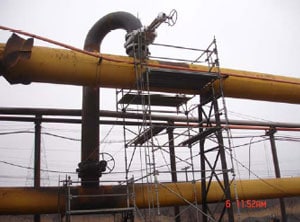
|
|
Figure 2. Example of bypass piping.
|
Both ends of the 54-inch line were blanked and the pipe was pressurized to determine if pipeline would have an acceptable loss rate. The 54-inch line did not pass this test, and the decedent’s employer checked for the locations of the leak points. The firm found bad valves, couplings, and welds. The decedent’s employer repaired the worst of them. When retested, there had been an acceptable loss rate. For the next few months, no activity occurred on the 54-inch pipe. Because of the successful pressure test, the site representative was unaware of any holes in or the need for patches on the 54-inch line. The site owner’s policy was that no one was to work and drill into a gas line unless it had been purged of gas. Per the purge schedule, the 54-inch line purge was to take place on Sunday.
The 54-inch line had been connected to the active 42-inch COG pipeline via two bypass piping sections, each with an isolation/gate valve at the connection end. The decedent’s employer hired subcontractor A to perform the hot tap operation on the live 42-inch pipeline. The pressure in the line was reduced from the active line pressure of 200 inches water column, so the gate valve and bypass piping could be installed and connected to the 54-inch pipeline. The site owner was responsible to purge the 42-inch line. The 30-inch hot taps to bypass the fuel over to the 54-inch pipe to the north and then another 30-inch hot tap back to the south were installed. The jumper pipes were placed. Condensate drip pots had been built, were heat traced, and insulated.
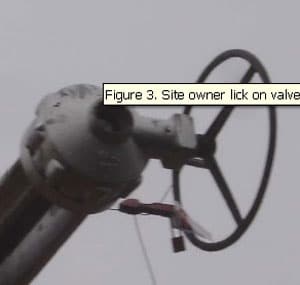
|
|
Figure 3. Site owner lock on valve.
|
Approximately two weeks prior to the incident, the subcontractor installed the two gate valves at the south end and north end of the 42-inch line. The 30-inch bypass pipelines were then connected to the 42-inch line at the gate valve locations. The site owner representative had met with the decedent’s employer on Wednesday (1/2/08), Thursday (1/3/08), and Friday (1/4/08) to discuss the time line and the exact scope of work, which was scheduled to begin on Sunday, January 6, 2008. The line purge procedure called for two nitrogen trucks to be ordered. The first nitrogen truck arrived on Friday, January 4. The second truck arrived at the site at approximately 7:30 a.m. on Saturday, January 5. The driver spotted the truck, and then drove down the length of the 54-inch pipeline. The driver did not note any workers at the site.
The decedent’s employer subcontracted the torch cutting work on the 54-inch pipeline to subcontractor B. The subcontractor performed a 28-inch hot tap and evenly spaced four drip pots along the pipe run. One drip pot had a valve open. The pipeline air had been checked for oxygen, carbon monoxide, and flammable gas levels. Results of the test showed normal results: 21% oxygen, 0% carbon monoxide and 0% flammable gas.
In the late afternoon on the day before the incident, the subcontractor hooked the last section and gate valve to the 54-inch dead pipeline. The four isolation/gate valves were in the closed position and only the locks of the site owner were in place (Figure 3). One of the decedent’s coworkers tested the 54-inch line for flammable gas using the site owner’s air monitor. Results were negative for flammable gasses. The crew supervisor installed the site owner’s locks on the bypass valves at south end of the 54-inch pipe and placed the control keys for the locks in lock-out box located in site owner’s utilities office. No locks associated with the decedent’s employer were placed on the valves.
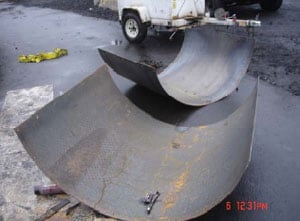
|
|
Figure 4. Gasketed steel cladding.
|
On the day of the incident, the five-person work crew arrived at the company trailer on the worksite between 7:30 and 8:00 a.m. The work crew consisted of a crew supervisor, ground man, and three pipe technician/line repair technicians. The ground man worked traffic control and assisted the pipe technicians with needed supplies, equipment operation, etc. The site owner was not expecting that work was going to be performed that day on the 54-inch line. The crew began working on the 54-inch pipeline between 9:00 and 10:00 a.m. The crew was working approximately at the midpoint between the two bypasses. The decedent and two of his crewmembers accessed the top and sides of the 54-inch pipeline that was located approximately 25 feet above the ground using a JLG lift device. After exiting the lift basket and climbing onto the pipe bridge, the crew tied off with safety harnesses and lifelines. The crew supervisor and ground man stayed below on the ground.
Three gasketed steel cladding patches were to be installed on the 54-inch pipeline to cover leaks (Figures 4 and 5). The crew foreman and the ground man worked on activities while on the ground under the pipeline. The decedent and his two crewmembers on top of the pipeline were making patch repairs on the 54-inch pipeline by bolting the gasketed steel cladding to the pipe using pneumatic drilling tools. The work crew did not bleed, purge, or perform air monitoring of the 54-inch line prior to beginning the day’s repair activities. The carbon monoxide (CO) monitors the crew wore on their jackets did not indicate any exposure to CO was occurring while they were performing the work. The crew completed one patch installation and then stopped for lunch at approximately 12:00 p.m.
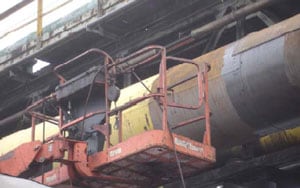
|
|
Figure 5. Gasketed steel cladding patches and man lift.
|
The crew returned to the worksite at approximately 12:45 p.m. Again, a man lift was used to transport the three workers up to the 54-inch line. The air in the pipeline was not evaluated for flammable gases prior to beginning work, nor purged or bled. One coworker (Coworker #1) climbed to the top of the pipe, the second coworker (Coworker #2) was located directly across the pipe from Coworker #1 on the iron work, and the decedent was located to the right and west of Coworker #1 on the same side and to the north of Coworker #2.
Approximately 45 minutes later, asCoworker #2 and the decedent were tightening down the patch bolts and Coworker #1 was tapping a hole, the pipe and ironwork began to shake. The explosion occurred south of the crew’s location. When the pipe exploded it pressurized the line and the pressure was too great for a nearby expansion joint that blew apart. The north piece of 54-inch pipe fell to the ground. The pressure release caused a large cloud of dust (Figure 6). A loud noise was heard by all of the crewmembers. The force of the explosion caused the decedent to be blown backwards with tremendous force, causing life-ending injuries.
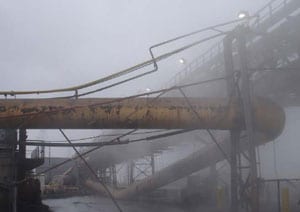
|
|
Figure 6. Parking area into which the decedent was attempting to turn.
|
Coworker #1 reported that he felt some warmth and traveled down the pipeline to a nearby building and climbed onto the roof. From the roof he saw flames at the south end of the pipeline. When he descended the ladder to the ground, he walked around this building and saw part of the pipeline that crew was working on lying on the ground. After a few moments he saw the decedent hanging by his lanyard upside down from the ironwork. As Coworker #1 left his site on the pipeline, Coworker #2 unhooked his lanyard and climbed down the ironwork to reach the ground. He looked for his coworkers, and saw that Coworker #1, the ground man and the supervisor were apparently unharmed. He also noted the decedent hanging upside down in his harness. Coworker #2 walked to the road and then to the work truck. He grabbed danger tape and taped off some areas and waited by the truck until the site security personnel arrived. The force of the explosion threw the ground man against nearby wall. The supervisor and ground man were both covered in dust but unhurt. The ground man, supervisor and Coworker #1 all went to the work truck to wait until the site’s security team arrived.
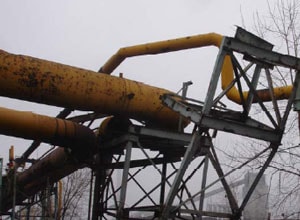
|
|
Figure 7. End of pipe where blank exited.
|
It is unknown who called for emergency response. When the responding police arrived, the decedent was hanging in his harness. The responding police officer spoke with a site security team member who stated that after arrival at the incident site he had attempted to perform first aid on the decedent while he was still hanging in the harness. The security team member stated that he could not feel a pulse or see signs of life. Other security team members escorted the decedent’s coworkers to the security team’s truck. When emergency response arrived, the surviving crewmembers were placed in an ambulance and taken to a local hospital. It is unknown who lowered and removed the decedent from his harness. The decedent was declared dead at the scene.
The site owner’s area utilities manager walked the area after the explosion and found all four bleeder valves in the closed position. He also noted that the four main gate valves were in the closed position and were cabled and locked. The force of the explosion caused a blank to travel down the length of the 54-inch pipe and break through the end of the pipe (Figure 7). The blank fell to the ground.
MIFACE was informed that a third party was contracted to determine how the presence of flammable gas in the 54-inch line occurred. MIFACE contacted the decedent’s employer and asked for a copy of this report. A copy was not provided.
Back to Top
Cause of Death
The cause of death as listed on the deathcertificate was multiple injuries due to explosion. Blood toxicology was negative for alcohol and illegal drugs.
Recommendations/Discussion
Employers should always treat pipes as “active” and test pipes for explosive gases before initiating and/or continuing any work on the pipe after a period of inactivity.
The company owner did not consider the pneumatic drilling being performed on the 54-inch line as “hot work”. Coke oven gas can contain hydrogen and methane, ammonia, carbon monoxide, carbon dioxide, ethane, ethylene, benzene, oxygen and nitrogen, hydrogen sulfide, water vapor, cyclopentadiene, toluene, naphthalene, hydrogen cyanide, cyanogen, and nitric oxide. Sparks from contact of the pneumatic drill and the metal pipeline may have initiated the explosion. If the line had been tested at various areas of the pipeline, the flammable gas may have been detected and this incident avoided.
Employers who are performing work on machines or equipment where unexpected energization, start-up or release of stored energy could occur and cause injury should always place their own lock(s) on the machinery/equipment if their workers are scheduled to be the first to perform work.
Although it is known that flammable gases must have been present in the 54-inch pipeline, the mechanism of how the gases got there is unknown. The site owner did not apply the site owner locks. The decedent’s employer applied the site owner locks, whose lockbox for the keys was in one of the site owner’s trailers. It appears that all pertinent valves were closed and locked out using the site owner locks. It is unknown if at some time these locks were removed and the valves opened and then shut and relocked. The decedent’s employer did not place their locks on the valves to ensure the valves stayed closed. If the decedent’s company had placed their locks on the valves and kept the keys in a secure area in their trailer, this would have provided an added assurance that the valves would not be opened without the knowledge of the decedent’s employer’s workers.
Site owners and subcontractors should ensure that effective communication is established for all site work.
Several meetings occurred in the days preceding the incident. The site owner indicated that he did not know work was scheduled to be performed on the 54-inch line by the decedent’s employer on the day of the incident. The purge procedure called for the site owner to perform air monitoring of a pipeline. If the site owner had been informed of the upcoming work, the line could have been tested and the incident avoided.
References
MIOSHA standardsexternal icon cited in this report may be found at and downloaded from the MIOSHA, Michigan Department of Energy, Labor & Economic Growth (DELEG) website at: www.michigan.gov/mioshastandards. MIOSHA standards are available for a fee by writing to: Michigan Department of Energy, Labor & Economic Growth, MIOSHA Standards Section, P.O. Box 30643, Lansing, Michigan 48909-8143 or calling (517) 322-1845.
- MIOSHA Construction Safety and Health Division, The Control Of Hazardous Energy Sources, Part 85.
- Robertson, T. Paper #34: Coke Oven Gas Condensate Hazardous Waste Issues. Environmental Quality Management Inc., 3325 Durham Chapel Hill Boulevard, Suite 250, Durham, North Carolina, 27707. http://www.eqm.com/pdf/Coke-Oven-Gas-Condensate.pdf (Link no longer available 8/14/2012)
Key Words: Explosion, Pipeline, Coke oven gas, Construction
Michigan FACE Program
MIFACE (Michigan Fatality Assessment and Control Evaluation)external icon, Michigan State University (MSU) Occupational & Environmental Medicine, 117 West Fee Hall, East Lansing, Michigan 48824-1315; http://www.oem.msu.edu. This information is for educational purposes only. This MIFACE report becomes public property upon publication and may be printed verbatim with credit to MSU. Reprinting cannot be used to endorse or advertise a commercial product or company. All rights reserved. MSU is an affirmative-action, equal opportunity institution. 03/06/09
Link updated 11/23/2010, http://www.oem.msu.edu/MiFACE_Program.aspx
MIFACE Investigation Report #08MI001 Evaluationpdf iconexternal icon (see page 11 of report)
External link: http://www.oem.msu.edu/MiFace/08MI001.pdf#page=11
